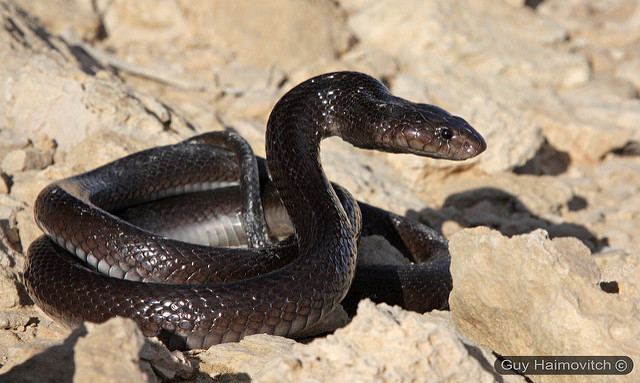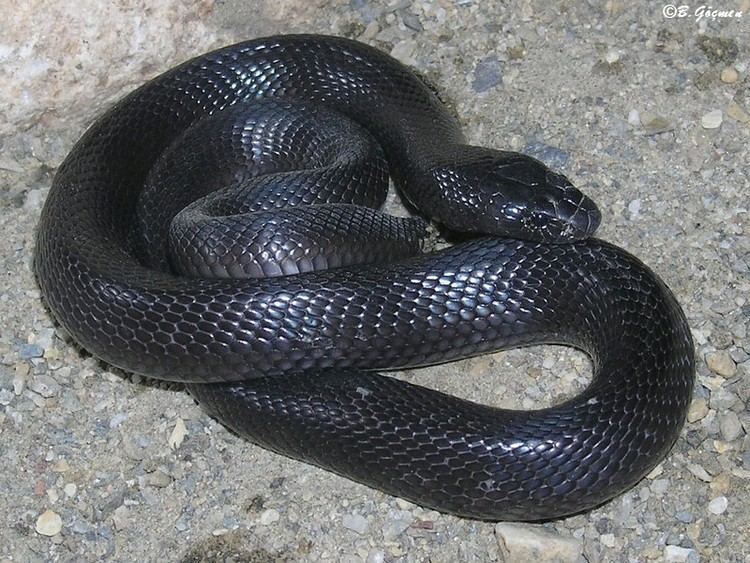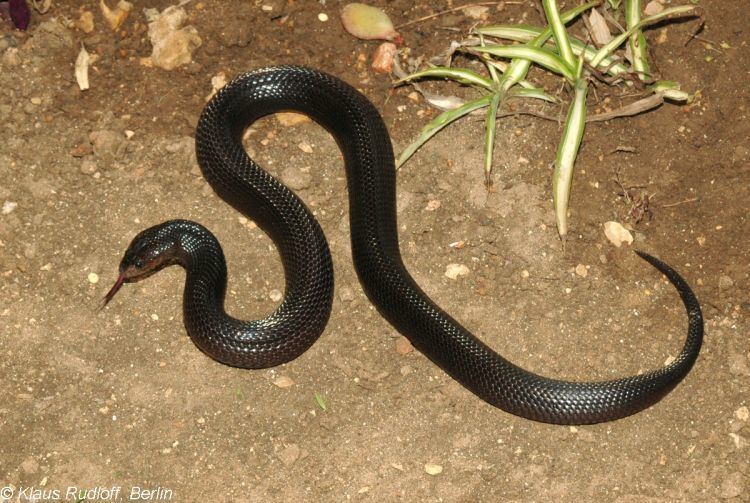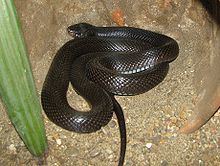Subphylum Vertebrata Scientific name Walterinnesia aegyptia Rank Species | Higher classification Walterinnesia | |
 | ||
Similar Snake, Walterinnesia, Reptile, Elapidae, Vipera palaestinae | ||
Black desert cobra walterinnesia aegyptia hissing
Walterinnesia is a genus of venomous elapid snake, also known as the Desert Black Snake or Black Desert Cobra. It was long considered to be the only species within the genus Walterinnesia. However, it was recently found that the eastern populations actually represent a different species, W. morgani. W. aegyptia is entirely black in color, and has highly shiny scales. W. morgani differs in having a juvenile pattern of reddish crossbars on the back, and lower average ventral and subcaudal scale counts.
Contents
- Black desert cobra walterinnesia aegyptia hissing
- Kamel badawi walterinnesia aegyptia
- Physical description
- Geographical range and habitat
- Habitat
- Behaviour and diet
- Diet
- Venom
- References

Kamel badawi walterinnesia aegyptia
Physical description

These snakes are medium in length, with a medium, cylindrical body and a short tail. Their average length is 0.5 meters (1 ft 8 in), but they can grow to lengths of 1.8 meters (5 ft 11 in). Their head is moderately small, broad, flattened and slightly distinct from the neck. The snout is broad, sharply edged with a distinct canthus rostralis. The eyes are small in size with round pupils. Dorsal scales are smooth anteriorly and weakly keeled on the posterior part of the body and tail. They are very glossy throughout. Dorsal scale count 27 (24 to 29) - 23 (21 - 25) - 17. Unlike other snakes commonly referred to as "cobras", the black desert cobra neither rears up nor produces a hood before striking in defense.
Geographical range and habitat

They are native to the Middle East. Walterinnesia aegyptia is found in the countries of Egypt, Lebanon, Jordan,. Israel, Palestine, and northwestern Saudi Arabia. It may also be found in areas of Syria that border Lebanon.
Habitat

This species occurs in the desert (excluding completely sand deserts such as the ad-Dahna Desert). They can also be found in semi-desert scrublands and rocky terrain, extending into the foothills of vegetated Mediterranean terrain. They are also often found near human habitation in irrigated agricultural settlements.
Behaviour and diet

The Desert black snake are nocturnal and are strictly terrestrial snakes. They are most active around midnight. They actively pursue and forage for their prey and rather than envenomate its prey with an open mouth, they'll usually bite their prey sideways at short distances and often use constriction and suffocation techniques in addition to their venom to kill their prey. There are reports of this snake being aggressive when molested, but like most snakes, it will usually try to escape rather than immediately bite or face their threat. Venom is not injected immediately when it bites but released seconds later with chewing movement.
Diet
This species feeds mainly on lizards such as skinks, geckos, agamids, other snakes, toads and occasionally mice and birds. It will also readily eat carrion.
Venom
This species is highly venomous. The subcutaneous LD50 for the venom of W. aegyptia is 0.4 mg/kg. For comparison, the Indian cobra's (Naja naja) subcutaneous LD50 is 0.80 mg/kg, while the Cape cobra's (Naja nivea) subcutaneous LD50 is 0.72 mg/kg. This makes the W. aegyptia (or Desert Black Snake) a more venomous snake than both. Like all elapid snakes, the venom is primarily neurotoxic and effects of envenenomation are from systemic circulation of the toxins rather than from local effect on tissue near the site of injection.
A survey of the literature revealed only a few clinical cases reported. Most of the information concerning W. aegyptia was collected from laboratory and animal studies.
